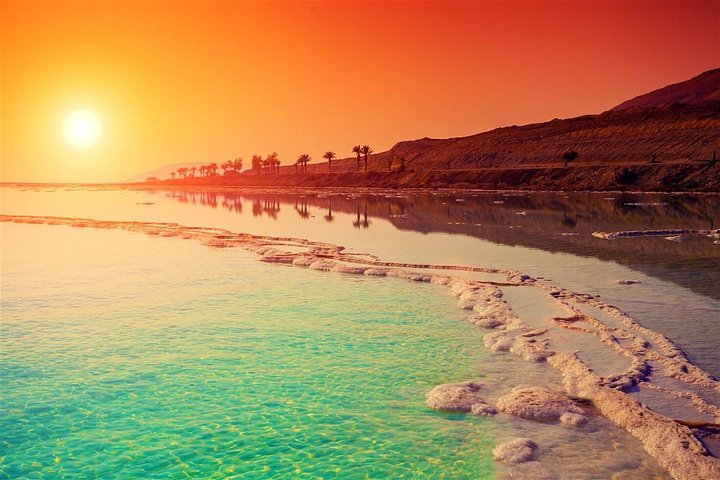Following the Red City: Five Days Through Petra, Wadi Rum and the Dead Sea
Five days bridging history, desert, and the buoyant hush of the Dead Sea
You emerge from the siq into the Treasury and the desert exhales. Stone, sand and sky conspire to make you feel small in the best possible way: the carved façade is at once human handiwork and geological miracle, its rose-red face lit by a late-morning sun that seems to measure time by color. This is Petra—half-hidden, half-remembered—and over five days you move through layers of history and landscape: Byzantine mosaics in Madaba, views from Mount Nebo, the buoyant hush of the Dead Sea, then the wind-sculpted loneliness of Wadi Rum.
Trail Wisdom
Start Petra at dawn
Beat the heat and the crowds—arrive early to see the Treasury in soft light and to avoid steep midday sun.
Hydrate for elevation shifts
Carry at least 2 liters per day; the Dead Sea is low and dry while Wadi Rum nights are cool and dehydrating.
Wear grippy shoes
Trails in Petra and Wadi Rum are uneven and sandy—sturdy hiking shoes with good tread reduce slip risk.
Book a registered Bedouin camp
Choose camps that employ local guides and cooks to ensure your visit benefits the community and follows park rules.
Local Knowledge
Hidden Gems
- •Little Petra (Siq al-Barid) – quieter Nabataean site near Petra
- •Dana Biosphere Reserve viewpoint and short walks for dramatic scenery
Wildlife
Nubian ibex, Red fox (desert fox)
Conservation Note
Tourism impacts fragile desert soils and archaeological sites—stick to marked trails, use registered guides, and support local Bedouin-run camps.
Petra was the capital of the Nabataean kingdom and flourished as a trade hub from the 4th century BCE; Madaba preserves a famous 6th-century Byzantine mosaic map.
Seasonal Guide
spring
Best for: Wildflower blooms, Comfortable hiking temps, Clear skies
Challenges: Occasional spring winds, Cooler desert nights
Spring offers mild days and blooming desert flora—ideal for walking Petra and camping in Wadi Rum.
summer
Best for: Long daylight hours, Dead Sea floating, Off-peak crowds
Challenges: High heat (especially in valleys), Midday hiking risks
Summer is hottest and best for Dead Sea bathing; avoid midday outdoor exertion and plan early starts.
fall
Best for: Stable weather, Golden light at sunset, Comfortable nights
Challenges: Shortening daylight hours, Busy tourist season
Fall is arguably the best balance of temperature and light, excellent for photography and hiking.
winter
Best for: Clear crisp mornings, Fewer tourists, Cool nights for sleeping
Challenges: Cold desert nights, Occasional rain or muddy conditions
Winter nights can be cold—pack warm layers—but days are pleasant for exploring ruins and deserts.
Photographer's Notes
What to Bring
Sturdy hiking shoesEssential
Support and traction for rocky paths in Petra and sandy dunes in Wadi Rum.
Reusable water bottle with filter or 1.5–2L bladderEssential
Keeps you hydrated across long transfers and dry desert days.
Sun protection (hat, sunscreen, sunglasses)Essential
The sun is intense across the valley; protect skin and eyes during outdoor time.
Warm layers and a light insulated jacket
Desert nights can become unexpectedly cold, especially in winter months.
Common Questions
Do I need to be fit to do this tour?
You should be comfortable walking 2–4 hours a day on uneven ground and stairs; guides pace the groups and vehicle transfers reduce long treks.
Is it safe to float in the Dead Sea?
Yes—floating is safe but avoid getting water in your eyes or mouth, rinse off after, and don’t shave immediately before the float to prevent irritation.
Are permits required for Petra or Wadi Rum?
Entrance fees for Petra and Wadi Rum protected area fees apply; reputable tour operators typically include these in the package.
Can I charge electronics and use phone service?
Charging is widely available in hotels and camps with varying reliability; cell service is good in towns but patchy in remote Wadi Rum canyons.
Are drones allowed for photography?
Drones require permits from Jordanian authorities; check with your tour operator before flying any drone in protected areas.
How should I respect local culture and customs?
Dress modestly in towns and religious sites, ask before photographing people, and accept invitations to local meals with gratitude.
What to Pack
Reusable water bottle for hydration; sunhat and sunscreen for intense sun; sturdy hiking shoes for uneven terrain; warm layer for cold desert nights.
Did You Know
The Dead Sea is the Earth's lowest elevation on land at about 430 meters (1,411 feet) below sea level and its high salinity makes it one of the world's saltiest bodies of water.
Quick Travel Tips
Carry Jordanian dinars for small purchases; negotiate taxi fares in Amman; book Petra entry in advance during high season; bring cash for Bedouin camp tips and extras.
Local Flavor
After a day in Petra, eat at Wadi Musa’s local restaurants—try mansaf or mezze—and visit Petra Kitchen for a hands-on cooking session; in Amman, seek out a hummus or falafel stall and enjoy rooftop views of the Citadel. In Wadi Rum, accept Bedouin tea and a lantern-lit dinner for an authentic evening.
Logistics Snapshot
Closest airport: Queen Alia International Airport (AMM). Driving distance: Amman to Petra ~3–4 hours (≈230–250 km). Cell service: reliable in cities, patchy in Wadi Rum. Permits/fees: Petra and Wadi Rum entrance fees required; visa requirements depend on nationality; private tour operator typically handles logistics.
Sustainability Note
The desert and archaeological sites are fragile—stay on paths, avoid leaving waste, use refillable bottles, and choose local Bedouin-run camps to ensure tourism income supports the community.

